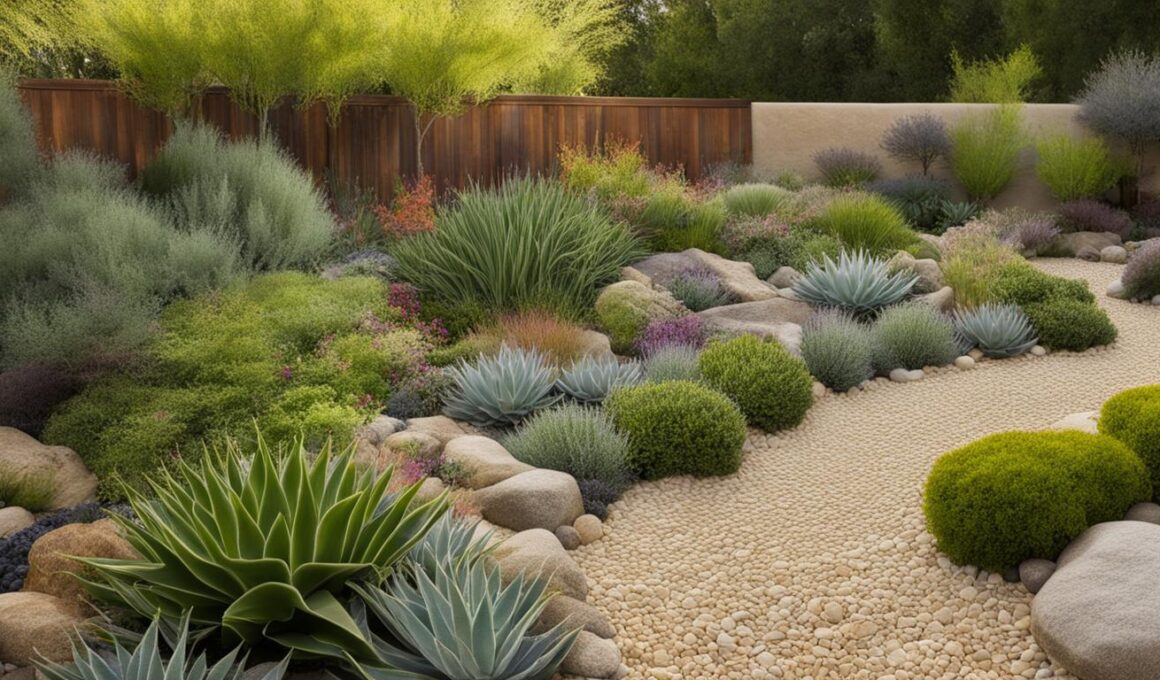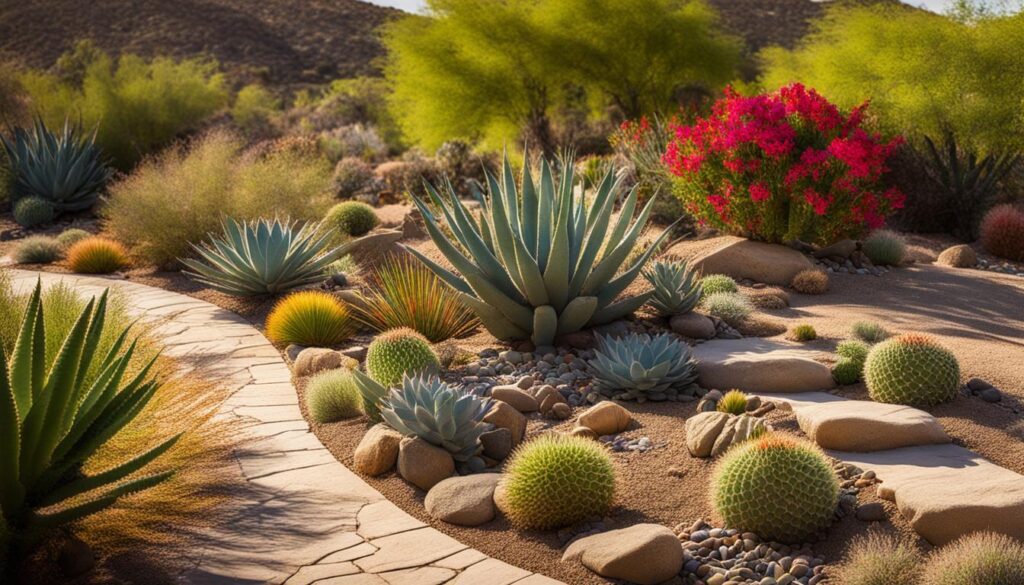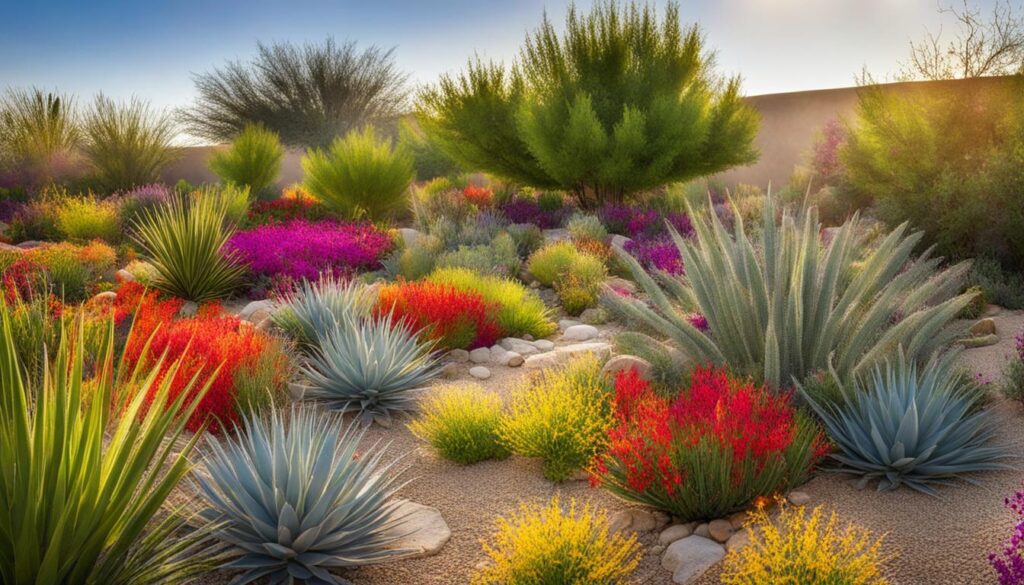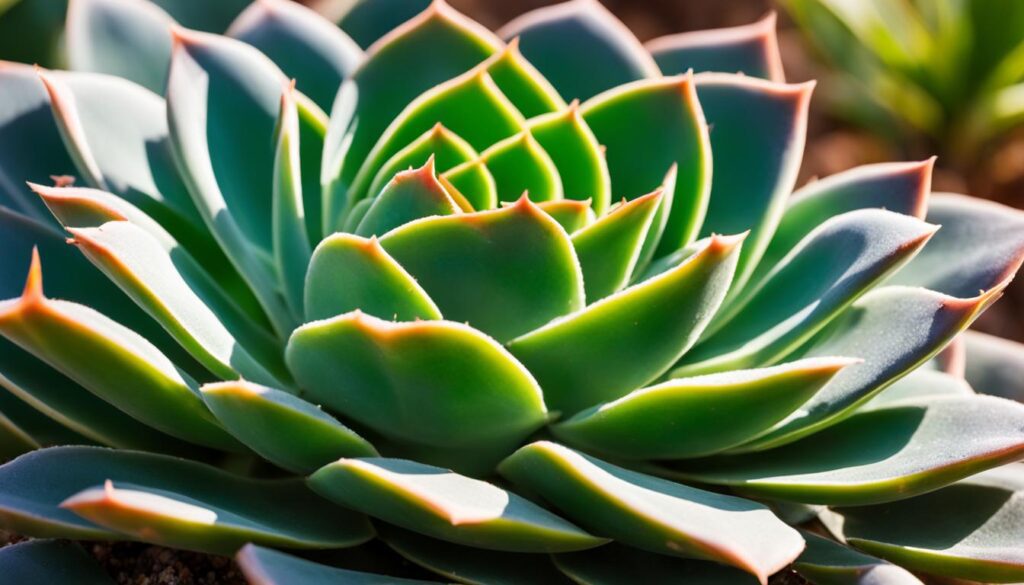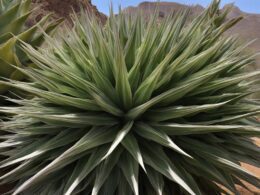Are you ready to transform your garden into a beautiful oasis in dry climates? Discover the art of xeriscaping and create a water-wise garden that thrives with minimal water. With the use of drought-tolerant plants and smart landscaping techniques, you can create a sustainable and low-maintenance outdoor space. Say goodbye to high water bills and hello to a vibrant and eco-friendly landscape.
Key Takeaways:
- Xeriscaping is a sustainable landscaping method for hot, dry climates.
- It involves the use of drought-tolerant plants to conserve water.
- Xeriscaping reduces maintenance and creates an environmentally friendly garden.
- By selecting region-appropriate plants, you can enhance the growth and care of your xeriscape.
- Consider installing a drip irrigation system for efficient watering.
What is Xeriscaping?
Xeriscaping is a landscaping method that is specifically designed for hot, dry climates where water scarcity is a major concern. It involves the cultivation of xerophytes, which are plants that are adapted to thrive in arid conditions. Xerophytes include cacti and succulents, which are known for their ability to store water in their leaves and stems. This natural adaptation allows them to survive and thrive even in environments where water is limited.
One of the key principles of xeriscaping is water conservation. By using xerophytes, which require minimal watering, you can significantly reduce your water usage in your garden. These plants have evolved to store water efficiently, allowing them to survive in the intense heat and dryness of hot climates. Xeriscaping is an ideal solution for those living in areas with water restrictions or limited water resources.
“Xeriscaping is a landscaping method that conserves water by using drought-tolerant plants and implementing water-efficient practices.”
Benefits of Xeriscaping
Xeriscaping offers numerous benefits, making it an attractive choice for homeowners in dry climates. By implementing xeriscaping techniques, you can not only reduce your water consumption but also create a visually appealing and sustainable garden. Here are some key benefits of xeriscaping:
- Water conservation: Xeriscaping requires minimal irrigation, reducing the amount of water needed to maintain a healthy garden.
- Environmental sustainability: By using drought-tolerant plants, xeriscaping helps preserve water resources and reduces the need for chemical fertilizers and pesticides.
- Low maintenance: Xeriscaping minimizes the need for mowing, watering, and pruning, saving you time and effort in garden maintenance.
- Heat tolerance: Xerophytes are well-suited to hot, dry climates, making them more resilient to extreme temperatures and reducing the risk of plant failure.
In summary, xeriscaping is a landscaping technique that prioritizes water conservation and sustainability in hot, dry climates. By incorporating drought-tolerant plants like cacti and succulents into your garden, you can create a beautiful and low-maintenance outdoor space while reducing your environmental impact.
Benefits of Xeriscaping
Implementing xeriscaping techniques in your garden offers a multitude of benefits, both for the environment and for homeowners. By embracing xeriscaping, you are contributing to a more environmentally friendly landscape.
Xeriscaping promotes water conservation, which is crucial in dry climates with limited water resources. By using drought-resistant plants and strategically grouping them based on their watering needs, you can significantly reduce your water usage. This not only helps to preserve precious water resources but also lowers your water bills.
Another advantage of xeriscaping is its easy maintenance. Xeriscape gardens require less pruning and trimming due to the slow growth of xerophytes, making them perfect for those with a busy schedule or limited gardening experience. Additionally, the use of native plants in xeriscaping can further simplify maintenance, as these plants are well-suited to the local environment.
Xeriscaping is an environmentally friendly landscaping method that reduces pollution, conserves water, and requires minimal maintenance.
Environmental Benefits
- Xeriscaping eliminates the need for excessive mowing, reducing air pollution caused by lawnmowers.
- By avoiding the use of pesticides and synthetic fertilizers, xeriscaping helps to protect water quality and minimize chemical contamination.
- The use of native plants in xeriscaping supports local ecosystems and enhances biodiversity.
Water Conservation
- Xeriscaping reduces water usage by utilizing drought-resistant plants and grouping them based on their watering needs.
- The efficient use of water in xeriscaping preserves water resources and helps combat water scarcity.
- Xeriscaping can reduce overall water bills, saving you money in the long run.
Easy Maintenance
- The slow growth of xerophytes requires less pruning and trimming, reducing the time and effort needed for garden maintenance.
- Native plants in xeriscaping are well-adapted to the local climate, making them more resilient and easier to care for.
In summary, xeriscaping provides numerous benefits that make it an attractive choice for homeowners in dry climates. Not only is it environmentally friendly and promotes water conservation, but it also offers easy maintenance and the potential for cost savings. By incorporating xeriscaping techniques and native plants into your garden, you can create a beautiful and sustainable landscape that thrives even in the face of water scarcity.
– How to Maintain Xeriscaping Techniques in Dry Climates for Long-Term Sustainability?
When it comes to maintaining xeriscaping techniques in dry climates for long-term sustainability, following these tips for xeriscaping maintenance can make all the difference. Conserving water, choosing native plants, and using mulch are essential for keeping your xeriscaped garden thriving in arid conditions.
Planning and Designing Your Xeric Garden
When it comes to planning and designing your xeric garden, there are several important considerations to keep in mind. By following these guidelines, you can create a beautiful and sustainable outdoor space that is tailored to your specific needs and the unique characteristics of your dry climate.
Choose Drought-Resistant Plants
One of the key elements of a successful xeric garden is the selection of drought-resistant plants. These plants are able to thrive with minimal water, making them ideal for hot and dry climates. Look for species that have evolved to withstand arid conditions, such as succulents, cacti, and other desert-adapted plants. Incorporating a variety of these species into your garden will not only add visual interest but also ensure that your plants can survive and flourish with little to no additional watering.
Create Water Zones
Grouping plants together based on their watering needs is an effective way to conserve water and reduce maintenance in your xeric garden. By creating different water zones, you can allocate your limited water resources more efficiently. Place plants with higher water requirements closer to a water source and those with lower water needs further away. This will allow you to easily adjust your watering schedule and reduce water waste.
Consider Removing the Lawn
In dry climates, traditional lawns can be a water-intensive and high-maintenance feature. Consider removing your lawn and replacing it with alternatives such as mulch, rocks, or gravel. These options not only reduce water evaporation but also inhibit weed growth and provide a more environmentally friendly solution. Additionally, you can use ground covers that are well-adapted to your region for a lush and low-maintenance look.
Choose Region-Appropriate Plants
When planning your xeric garden, it’s important to select plants that are well-suited to your specific region and climate. Native plants are particularly recommended, as they have evolved to thrive in your local environment and are naturally adapted to the temperature, rainfall, and soil conditions. These plants are more likely to require less care, be more resistant to pests and diseases, and have a better chance of survival in your xeric garden.
Consider Irrigation Considerations
Efficient irrigation is crucial to the success of your xeric garden. Consider installing a drip irrigation system, which delivers water directly to the plant’s roots, minimizing evaporation and water waste. This method can be further enhanced by incorporating rainwater harvesting systems, which allow you to collect and reuse rainwater for irrigation purposes. By implementing these irrigation considerations, you can maximize water efficiency and minimize the environmental impact of your xeric garden.
By following these planning and design tips, you can create a stunning xeric garden that is not only visually appealing but also sustainable and water-wise. Remember to choose drought-resistant plants, create water zones, and consider removing your lawn. Incorporate region-appropriate plants and make irrigation considerations to ensure the long-term success of your xeric garden. With these strategies in place, you’ll be well on your way to enjoying a beautiful, low-maintenance outdoor space that thrives in even the driest of climates.
Conclusion
By incorporating xeriscaping tips into your garden design, you can create a water-wise landscape that is both sustainable and visually stunning. With the use of drought-resistant plants and proper planning, you can conserve water and reduce maintenance, while still enjoying a beautiful outdoor space.
Water-wise landscaping is not only beneficial for the environment, but it also helps to lower your water bills and conserve precious resources. By selecting region-appropriate plants and grouping them based on their watering needs, you can ensure optimal growth and reduce the amount of water required for irrigation.
Remember, sustainable gardening practices such as xeriscaping are not limited to dry climates. Whether you live in an arid region or not, xeriscaping techniques can still be implemented to create a low-maintenance landscape that is both environmentally friendly and visually appealing. So why wait? Start transforming your garden today with xeriscaping and reap the benefits of a beautiful, sustainable outdoor space.





